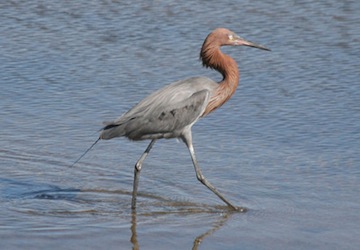350715-reddish_egret.jpg

Reddish egrets were hunted to near extinction for their colorful plummage. Credit: John C. Avise. University of California, Irvine
It doesn’t always pay to be beautiful. By the early 20th century, for example, several shorebirds had been hunted to near-extinction for their beautiful plumage. They needed federal protection to keep them from disappearing.
One species that has made a bit of a comeback from those gloomy days is the reddish egret — a type of heron that’s found in marshes and lagoons along the Gulf Coast. The adults stand a couple of feet tall, and most of them have cinnamon-colored feathers on their heads, necks, and breasts. Those feathers were popular decorations for women’s hats, so the birds were slaughtered by the thousands.
Today, the population is probably in the low tens of thousands. About 2500 of those live in Texas. During the spring and summer breeding season, they build nests in scrubby trees or in patches of prickly-pear cactus.
Beside its plumage, the reddish egret is best known for its feeding habits. As it wades through shallow waters, it spreads its wings to form a shady canopy. That allows it to see small fish, frogs, and crustaceans in the water. The shade also attracts fish, making them easy prey. And the egret chases fish that try to get away. It runs in circles, jumps sideways, and performs other acrobatic moves.
Although its numbers have picked up, the egret isn’t in the clear. It faces threats from coastal development, pesticides, and other human activities. In Texas, at least, it’s listed as a threatened species — even though it gets to hang on to its beautiful plumage.
This episode of Science and the Sea was made possible by Texas Sea Grant.

